
The Atamate Schools project is intended to meet the following objectives for schools:
Air quality is impacted by carbon dioxide, volatile organic compounds, nitrogen oxides and humidity. Good air quality management has many benefits:
The Atamate building operating system includes air quality management among its functionalities.
As COVID-19 makes what we fervently hope is its final retreat and we dare to think about going back to work and staying there, it's as good a time as any to think about what we'll be going back to. In particular, the quality of the air we'll be breathing for eight hours out of every 24.
Air quality falls under the purview of facilities management which, depending on the size of the building, might be handled by a dedicated team or by one person with a dozen other responsibilities.
Indoor air quality is impacted by various factors:
There is no way to keep the pollutants out of a building - people have to breathe, after all - but we can tolerate low levels of pollutants and good ventilation keeps them at those low levels.
The regulatory parameters for indoor air quality are set out in Part F (ventilation) of the UK building regulations. However, there are good reasons to make air quality a management priority that goes beyond the minimum regulatory requirements which are discussed at length in the Chartered Institute for Building Engineers (CIBSE) TM40 document, which we have summarised in a previous article.
Here are five reasons why maintaining high air quality benefits an organisation:
When the air quality is good, everyone feels good. When the air quality is poor, everyone feels poorly.
We may not be able to analyse everything in the air by breathing it but we know when it's not right and we don't feel good about it. Eight hours is a lot of the day to not feel good, which should be a good enough reason for facilities management to prioritise air quality.
There is also a more practical reason: someone who is nursing a headache and trying not to doze off is not productive. Good air quality is a factor in making a workplace where work gets done instead of being a place that paid staff endure until they can escape from it.
As we've recently learned the hard way, making the indoor environment comfortable for ourselves also makes it very comfortable for respiratory viruses. Workplaces often place a lot of people in a small space and even with good ventilation, some respiratory droplets breathed out by one person will be breathed in by others along with any viruses contains in them.
Most respiratory viruses aren't as serious as COVID-19, which is so dangerous that it's forced us to spend the best part of a year avoiding sharing spaces with each other. However, there are around 200 viruses that cause the common cold, which won't kill us but will certainly make us miserable and less productive.
Good ventilation reduces virus transmission by removing respiratory droplets from an indoor space before anyone breathes them in but there's more to controlling virus transmission than keeping the air flowing. Relative humidity of 40-60% is what we find most comfortable and is also the least conducive level for virus transmission. Heating without humidification often drives the relative humidity below 40% which makes it much easier for respiratory viruses to infect us and is the reason why we catch more colds in the winter than at any other time of year.
Our series on respiratory viruses in the indoor environment has more detail on why work is a good place to catch a cold and what to do about it.
Carbon dioxide in the atmosphere is between 400 and 450 parts per million (ppm) but it often rises higher in an indoor space where many people in close proximity are exhaling it.
The Health and Safety Executive's EH40/2005 document set an exposure limit of 5,000ppm over an eight-hour working day and allows exposure to up to 15,000ppm for a 15min period but while exposure to such levels will cause no long-term harm, they are likely to affect anyone exposed to them. Even at 1,000 and 1,500ppm, carbon dioxide can cause measurable cognitive impairment which will impact productivity and leaving staff feeling drowsy and unhappy.
We've seen how poor air quality can facilitate virus transmission, leaving staff with the choice of taking time off to recover or 'presenteeism', in which they drag themselves into work but get very little done other than to infect other staff who will then be faced with the same choice.
Even in the absence of viruses, poor air quality may do more than leave staff feeling drowsy or out of sorts. Those feelings tend to exacerbate chronic ailments and underlying mental health problems, making the difference between a manageable condition and an illness that requires time off work.
Even if poor air quality doesn't make someone ill, they'll know they're not feeling their best at work and are likely to look for reasons to not be there. Poor air quality encourages absence and discourages productivity.
It is also likely to impact staff retention. Someone who is unhappy at work and has the option of moving on is likely to take it, and it's usually the staff who are hardest to replace who have the most options for work elsewhere.
While considering the quality of the air and how it affects the people who breathe it, it's also worth considering how the air quality is maintained. Ventilation may involve opening windows, mechanical ventilation or a combination of the two. At Atamate, our experience is that both those approaches are often associated with significant energy waste which inflates an organisation's overheads.
Opening a window doesn't consume energy but it's not unusual for someone to open a window without noticing that the heating or air-conditioning systems - and occasionally both - are still running and pumping up the bills. Good management of ventilation can not only avoid such inefficiencies but can contribute to passive cooling in the summer, limiting the need for air-conditioning.
Mechanical ventilation uses extractor fans so there's no way to avoid using some energy but there are ways to keep that to a minimum. A common inefficiency is over-ventilation: running the ventilation system when the air quality is already high or when there is no one in a room to benefit from the high air quality that energy is being used to maintain.
Air quality is important but there is no reason to spend more than is needed to maintain it.
The Atamate building operating system (atBOS) can enhance the management of air quality in any type of building. The network of ceiling sensors allows the air quality in every room to be accessed either in real-time or in the form of reports that show how air quality fluctuates during the working day as we have covered in our article comparing a fixed sensor network with wearable sensors.
The data can be used to identify times or areas in which air quality is poor, allowing it to be addressed by opening windows, switching on a ventilation system or whatever is appropriate for the building.
Extending atBOS to automate the services is the most energy-efficient way to deliver high-quality air. The approach will depend on the building and how it is ventilated but examples of possible improvements include:
If you'd like to know more about how atBOS can improve the air quality to a building or more about air quality in general, please fill in the form below and we'll be happy to get back to you.

The Atamate Schools project is intended to meet the following objectives for schools:

Today’s market offers a wide range of building management and automation systems with overlapping functionalities. We designed the Atamate building operating system...